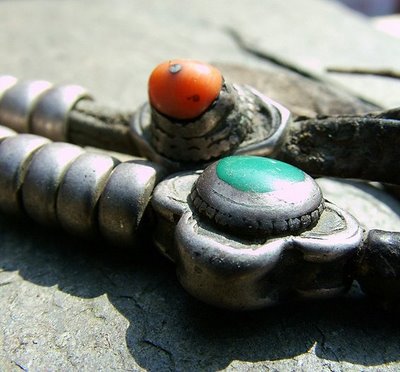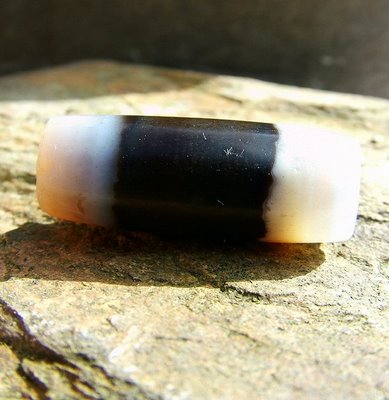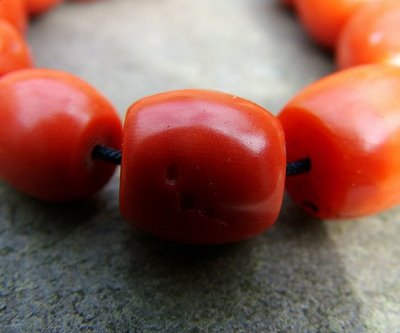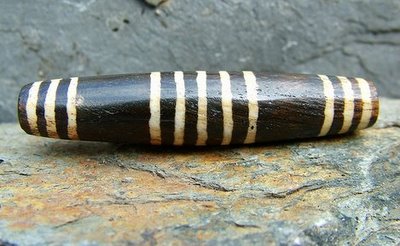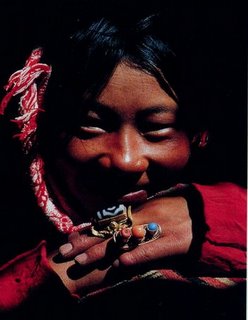Amongst the many dZi stories known by Tibetans, one common belief is that cattle can give birth to dZi. It is believed that dZi are wormlike creatures that the cattle eat whilst grazing. Once eaten these creatures become petrified, creating a perfect dZi bead. Tibetans also believe that the perforation found on dZi is a completely natural occurance and has not been drilled by man. However, there are some rare dZi that do not have perforations. Maybe these beads were not created to be worn but instead were used to adorn statues and other artifacts.
Saturday, April 29, 2006

Tibetan women with beaded hair braids.
Nomadic Tibetan women often wear their hair in two styles of braids. They may choose to wear it in large braids (slas chen) or small braids (slas zhib). Girls who are unmarried often comb their hair into three large braids and rarely wear ornamnents in their hair, apart from the occasional piece of amber, coral or turquoise. Once a girl is married this will then change as she can now start to wear it in the fashion shown above. This style is called 'Pakma Trale'. These braids are considered a very important part of the wedding ceremony. There are usually 108 braids which is a sacred an auspicious Buddhist number. As a married woman she will start to wear an increasing number of hair ornaments that usually consist of large pieces of amber, coral, turquoise and dZi.
Here we have antique silver counters from east Tibet. They have been inlaid with coral and turquoise. Counters are used to keep track of large numbers of mantra recitations or prayers. They are traditionally strung on 108 bead malas. I have also noticed that some Tibetan traders also use them as a calculator. For this purpose they are simply worn around the neck on a piece of cord for easy access.
This is a beautiful translucent ancient agate bead. This picture allows us to see how the perforation was made. We can see that the bead was drilled at both ends and that these lines eventually meet to form a complete perforation.
The link below will take you to an interesting article that gives further information on ancient drilling methods.
http://www.lapidaryjournal.com/feature/299str.cfm
The link below will take you to an interesting article that gives further information on ancient drilling methods.
http://www.lapidaryjournal.com/feature/299str.cfm
Photo: The giant Pema Raka bead measures 88.36 mm x 75 mm
This is an early imitation coral bead made from glass. They are known as 'Sherpa' Coral because they are a popular adornment with the Sherpa women of Nepal. The earliest beads may have been made towards the end of the 19th century and traded as an affordable alternative to genuine red coral. Many are much later creations. In the Tibetan language shar means East; pa is a suffix meaning 'people': hence the word sharpa or Sherpa. In recent years, many of the Sherpa people have migrated to India. Sherpas originally came from East Tibet and migrated to Nepal within the last 500 years.
Thursday, April 20, 2006
Round Pumtek beads displaying the more commonly seen 6 stripe design. Genuine beads are originally from Burma (Myanmar) and are made from silicified woods. Pumtek are once again being made by bead makers in Burma using similar materials and methods as their ancestors. This can often make it difficult to distinguish the 20th century beads from much earlier creations. These beads were purchased from Tibetan traders in Nepal and are believed to be old but not ancient.
Above: Plastic imitation dZi beads.
Plastic imitation dZi beads can be found in different qualities and they can display both common and more unusual motifs to replicate designs found on ancient 'stone' beads. The bead in the foreground is a very convincing looking stone bead until you scrutinize it more closely. Jamey D. Allen shows similar beads in his wonderful Arts of Asia article and tells us that they have been in production for more than 30 years. They can be found in Tibet and throughout the Himlayan regions and India. It is therefore possible that there are a number of different sources for these beads.
Jamey D. Allen explains that they are made "from a three-step process". The first step is made by "moulding a white base with a raised design". The base is then covered with a darker outer layer and then lastly the surface needs "grinding" to make the bead smooth. Most of these plastic beads include a metal core which gives the bead extra weight and the illusion that they are crafted from heavier stone. Under magnification it is often possible to see tiny air bubbles and this indicates that they are not crafted from agate or any other type of stone material. If you gently tap them on your teeth they will feel dull like plastic and not hard like stone.
Subscribe to:
Posts (Atom)




